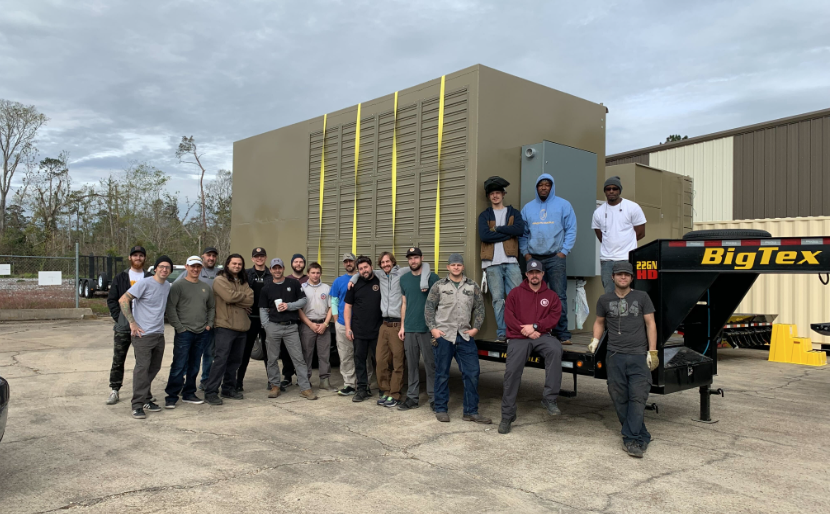Note: this is a dynamic report that gets updated as new data on new carbon negative Bitcoin mining, new carbon-neutral Bitcoin mining, miner efficiency (avg J/TH) and new estimated total Bitcoin network energy consumption becomes available. Current statistics may vary from those previously reported. Last updated: 21 July 2023
Introduction
The Bitcoin Mining Council has been quantifying the carbon-neutral portion of the Bitcoin network for over 18 months.
What has not yet been quantified, and of growing importance, is is the impact that the increasing amount of mining operators using carbon-negative energy sources are having on the overall Bitcoin network. This article is a first attempt to quantify this.
The amount of carbon negative power sources is really important to measure because it helps us predict when the entire Bitcoin network becomes a zero emission network.
As Carboncredits.com explains, methane combustion is a long-recognised forms of methane mitigation: “Methane can simply be burned off to create CO2. Since methane is over 20 times more harmful to the atmosphere than CO2, converting one molecule of methane to one molecule of CO2 through combustion still reduces net emissions by more than 95%.”
Methane is an 84x more warming greenhouse gas than CO2 over a 20-year period. It is now contributing as much to climate change as CO2. Combusting methane that would have otherwise been released into the atmosphere is widely recognised as a simple and effective path to becoming carbon negative. Unlike using renewable power sources, which are carbon neutral, using methane as a power source has a much stronger environmental benefit because it actually reduces the net amount of greenhouse gasses that would have gone into the air.
Summary of Findings
As of 21 July 2023, 1.3% of the Bitcoin network is powered by emission-negative sources: this is currently made almost entirely of previously atmosphere-bound methane from the Oil&Gas industry that was previously flared at up to 91.1% efficiency (8.9% methane released). However, because of methane’s 84x GWP over 20 years, this represents an offsetting of -2.3 Mt CO2e against today Bitcoin emissions of 40.5 Mt CO2e (a net emission reduction of 5.7%).
Generators are far more effective at removing methane. Crusoe Generators for example remove 99.89% of the methane (0.011% methane released).
Emissions impact:
180.35 MW of flared methane results in a reduction of 2.042 M t CO2e per year. (see calculations section below)
This is equivalent to planting 30 Million trees and letting them grow for 10 years.
The nascent sector of Bitcoin mining using vented methane reduces 224,000 t CO2e/year.
Total negative emissions: 2.3 M t CO2/year
Sustainable energy impact (section added and calculated 21 July 2023):
The impact of factoring in the 180.35 MW of flared gas power is a net +0.6% increase to the sustainable energy component of the Bitcoin network.
Methodology
We used publicly available information about different mining operations known to be combusting stranded methane that would otherwise have been released into the atmosphere. We assumed all mining operations were using natural gas that was previously flared, and that the flaring efficiency was 91.1%
Press releases variously reported the amount of megawatts of power used, Bitcoins mined in the last year, or number of ASICS purchased. In all three cases, it is a straightforward calculation to reliably estimate the total amount of hashpower (measured in exahash per second or EH/s) that mining operation contributes to the Bitcoin network. We assumed that mining operations using Biogas were at a very small scale that would not significantly alter the overall hashpower of the network. While several operations are in the pipeline, we could find no evidence of any mining currently occurring using wastewater or Landfill Gas. We therefore focused our attention only on mining operations using flared gas produced as a byproduct of the Oil and Gas industry.
We then calculated the amount of carbon emissions that would have been emitted if flared, and subtracted the net carbon emissions created through combustion to arrive at a net carbon reduction figure, using methane’s 20-year GWP (Global warming potential) of 84 (because methane is an 84x more powerful greenhouse gas than CO2 over a 20-year period.
The list of Bitcoin mining operations is not an exhaustive set, so as I become aware of more operations using flared gas, I add them to the list, and recalculate the total quantity of carbon negative mining. As such, at any one time the results may be slightly understated. I’ve also excluded very small operations (under 1.5 MW) from calculations.
Calculations
Crusoe Energy : 113.4 MW
How we know:
a. Prior to setting up their Bakken site, Crusoe were “diverting 10 million cubic feet per day of gas that would otherwise be flared.” So this represents 416,667 cubic feet of gas combusted per hour.
Natural gas generates 0.14 KWh per cubic foot, so this = 58,333 KW or 58.3 MW
b. Since then it was reported that they had established a new 25MW operation in North Dakota . So total MW = 58.3+25 = 83.3MW
c. Investigative research revealed that since Mar ’22, Crusoe have scaled up rapidly and now have 84 x 1.5MW modules fully operational. Average uptime is 90%, so that would represent 113.4 MW (an increase of 35% since Mar ’22).

Great American Mining: 10MW (Now part of Crusoe – Oct ’22)
How we know: Their website reports 20MW of total capacity. However, insider reports confirm that roughly half of this is flared gas, with the other half being stranded gas (excluded from the count)

jaienergy.com: 3.15 MW
How we know:
This is the one I could find least data on. I have contacted them to request more information on the breakdown of atmosphere-borne natural gas vs pipeline-sourced natural gas and am awaiting a reply.
Their total capacity is stated on their website is 175 MW. However, our investigations tell us that this is the Texas grid partnership with Mawson, financed by Celsius, which is not yet operational, and that the estimated amount of flared gas operations is ~10MW, comprised of 9x 350KW generators at their Powder River Site.
Nakamotor Partners : 3MW
How we know:
DMs with the founder on Twitter (3MW)

Green Mining Capital: 6MW
How we know:
Direct contact with the founder

Arthur Mining: 8 MW
How we know:
Direct contact with the company. In 2022, they shared that of 25MW publicly mentioned on their website, of which 14% of 3.5MW was flared gas. This increased to 8 MW at the end of Sept 2022 when their new operation in WY went live.

Imperium Digital: 3.5 MW
How we know: Direct contact with the founders + public information from their website.
Giga Energy: 12 MW
How we know: Direct contact with the founders
NodalPower: 4.8 MW
How we know: Direct discussion with founders plus review of company documents. Nodal Power were the first Bitcoin mining company to use landfill gas to provide electrical power for Bitcoin mining, although unlike Vespene they have so far used previously flared methane, not vented methane.

Anonymous #1: 12 MW
How we know:
During our interviews we were introduced to another US-based mining operation that have been operating beneath the radar for 7 years, and who are now using flared gas. They have asked not to have their name included in the report.
Exclusions: Numerous others use flared gas. However to our knowledge, these are all using <1MW of gas, so we have excluded them from the study. We will include them in future reports as they achieve scale. Landfill gas by contrast seems poised to increase significantly. We are aware of several operations of more than 1 MW in the pipeline. The first landfill gas-based mining operation using vented methane is Vespene, expected to open their first 1.5MW pilot site later in 2022.
Anonymous #2: 9 MW
How we know: During outreach to find people interested in vented mining, we uncovered more miners in O&G looking to move into this area. When asked if they would mind being identified they replied “We actually pride ourselves on being under the radar and it has been to our benefit thus far”
Flared Gas Total = 180.35 MW
S19Pro J/TH ratio = 3.25KW/(110 TH/s) ratio = 0.0295 KJ/TH. Because all but the anonymous sites came online post 2020, they will be using the S19Pro or equivalent miner. The remaining site is assumed to be operating with an older fleet of miners operating at 40 J/TH, giving an overall network efficiency of (139.05/151.05x 0.0295 + 12/12.65×0.04) = 0.0272+0.0040 = 0.0312 KJ/TH)*
* calculation based pre-update when the first 151.05 MW was discovered. I have not updated this, as the network efficiency calculation will not change materially.
So 180.35 MW of energy => 180.35/0.0312 = 5780 PH/s = 5.780 EH/s (Exahash per second)
Note: 132.5 MW of this growth happened in the last 16 months as of the time of first writing the report (Aug 2022). That’s a rate of 8.3 new MW power every month.
The Nascent Biogas sector
AmityAge Mining Farm, Scilling Digital Mining, Biomining and Easy Crypto Hunter all use Biogas
They all appear to be very small (under 100 S19Pros). Scilling for example currently operates with 69 S19Pros. Assuming these four operations to be of roughly equivalent size, this would mean ~276 latest generation miners, or 0.897 MW power. While small, because this biogas would otherwise have been 100% vented directly into the atmosphere, it has a much bigger carbon negative impact on the network than flared gas mining (where the flare already removes 91.1% of the methane). From analysis of net emissions when combusting biogas, each tonne of methane from biogas offsets 20 t methane that would have been vented. So it has a -19x multiplier effect.
0.897 is a tiny fraction of the Bitcoin network, only 0.013%. However, because it removes 20 t emissions for every 1 t it releases, the carbon negative impact on the Bitcoin network is -19×0.013 = 0.25%, which is not insignificant.
Combining the flared gas and biogas totals together, carbon negative power currently has a combined impact of 4.27%
Other key information
Calculating net CO2-e reductions:
Methane generates 9.81 Kw/m3. Microturbines and generators have efficiency of up to 35%. This means that to generate 1 MW, you would need 1000/(9.81×0.35) = 291 3. Methane’s density is 0.717kg/m3. So 291 m3 = 0.291×0.717 = 0.208 T. So 1 t generates 4.79 MWh
CO2-eq reduction from combusting flared gas = (Baseline CO2-eq reduction achieved by flaring) – (Combusted CO2-eq reduction)
Flared CO2-e reduction: Start with 30,000 t Methane
GWP20 84 Methane is 84x more warming than CO2 over a 20 year period CO2e 2,520,000 t
Baseline CO2e reduction 299,438 t CO2e/year
Combusted CO2e reduction 92,262 t CO2e/year
Net CO2 reduction 207,175 t CO2e/year
Methane power-to-tonnage formula: 1 MWh requires the combustion of: 0.208 t methane
Energy required: 16.46467 MW (over a full year)
16.4647 MW reduces 207,175 t CO2e/year therefore
1 MW reduces 12,583 t CO2e/year
=> 180.35 MW reduces 2.269 MT CO2e/year. However, assuming only 90% uptime, realistic figure is 2.04 Mt CO2e/year
Calculation details:
1 t Methane when burnt produces 2.75 t CO2 See Footnote 44. 16g Methane produces 44g
CO2 CO2-eq reduction from combusting flared gas = (Baseline CO2-eq reduction achieved by flaring) – (Combusted CO2-eq reduction)
= [(residual-methane x quantity CO2e) + (combusted methane x CO2-multiplier x quantity CO2)]flaring – [(residual-methane x quantity CO2e) + (combusted methane x CO2-multiplier x quantity CO2)]generation
= [(0.911x84x30000) + (0.911×2.75×30000)] – [(0.0011x84x30000)+(0.996×2.75×30000)
Document Revisions:
30 Aug ’22
Added new Bitcoin mining operation recently discovered using flared gas for a 12 MW facility.
Updated for new and higher Bitcoin network energy usage.
Included the impact of small biogas-based mining operations.
2 Sept ’22: Added new data from inside industry information on latest status of Crusoe rollout.
12 Feb ’23: Added “Sustainable energy impact” to “Summary of Findings” section. Revised “Other key information” section
21 Mar ’23: Revised net Mt CO2-e reductions using latest research on flaring’s 91.1% efficacy at removing methane
21 July ’23: Added Giga Energy
